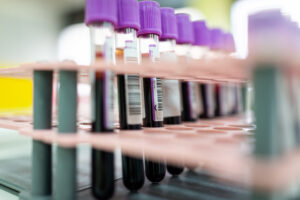In 2015 results from the Pragmatic, Randomized Optimal Platelet and Plasma Ratios (PROPPR) trial suggested that a 1:1:1 ratio of plasma to platelets to RBCs was best for severely bleeding trauma patients to achieve hemostasis, but no differences were observed in mortality. Most trauma centers now use a 1:1:1 ratio of blood products. Secondary analysis of data from the PROPPR trial, however, suggests that this ratio might not be the best resuscitation strategy for all severe trauma patients, specifically those with a specific molecular endotype characterized by higher cytokine levels (including interluken-8 and tumor necrosis factor-α). Two distinct trauma endotypes (TE) were identified using K-means clustering of 36 plasma biomarkers in a subset of the original participants (n=478; median age, 34.5 years; 80% male). Patients in TE-1 (n=270) had higher levels of plasma biomarkers at baseline (before randomization) and a greater risk of 30-day mortality compared to patients in TE-2 (n=208). Notably, trauma endotype was associated with a differential response to 1:1:1 vs. 1:1:2 transfusion resuscitation strategy. Thirty-day mortality was reduced for TE-1 patients transfused with a 1:1:2 ratio of blood products compared to 1:1:1 products (28.6% vs 32.6%). However, TE-2 patients had higher mortality when transfused with a 1:1:2 ratio vs. 1:1:1 (24.5% vs 7.3%). Further research is needed to better understand the pathological mechanisms for each endotype and develop point-of-care assays to measure pertinent plasma markers before transfusion resuscitation begins.
Reference:

